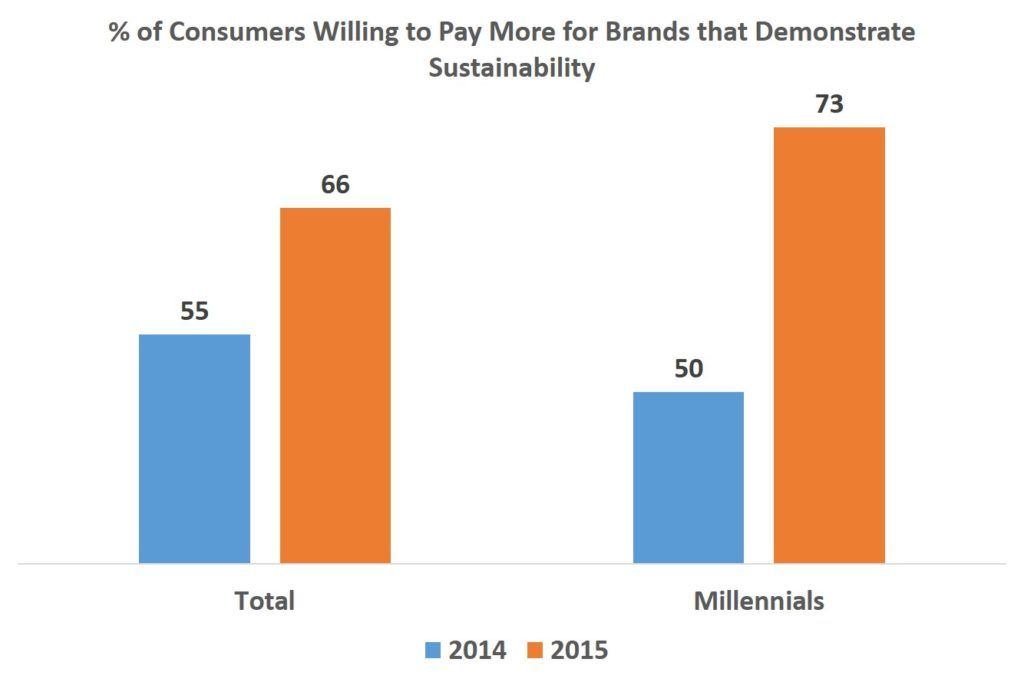Vote with Your Wallet and Race to the Top

PepsiCo should build on current sustainability initiatives to nudge consumers to vote with their wallets. It’s time to race to the top.
Background
PepsiCo’s supply chain is heavily reliant on commodities such as “sugar cane, corn, wheat, rice, oats, potatoes, and various fruits.” [1] Maintaining a cost-efficient supply chain of these key commodities will be a critical success factor for PepsiCo. PepsiCo recognizes that climate change poses a serious risk to this supply chain as detailed below.
Future Risks
PepsiCo’s 2015 annual report details the risks that the company needs to address. As a result of climate change, “we may be subject to decreased availability or less favorable pricing for certain commodities that are necessary for our products.” [2] Impacts on the supply of water driven by climate change is also a major concern for PepsiCo as water is heavily involved in irrigation of crops used to supply PepsiCo products. As quoted in the 2015 annual report, “deteriorated quality of water or less favorable pricing for water…could adversely impact our manufacturing and distribution operations.” [3] Climate change’s impact on extreme weather conditions is also a source of concern for PepsiCo. According to the report, “extreme weather conditions may disrupt the productivity of our facilities or the operation of our supply chain.” [4]
Future Opportunities and Current Steps Taken
While PepsiCo faces many risks due to climate change’s impact on crops, water availability, and extreme weather conditions, there are also opportunities. One area of opportunity is reducing the GHG emissions that result from business operations to reduce PepsiCo’s impact on the planet and improve bottom-line profitability by becoming more energy efficient. From PepsiCo’s 2015 GRI (“Global Reporting Initiative”) report, PepsiCo is committed to reducing its contribution to future GHG emissions which would decrease the likelihood that the risks mentioned above are realized. [5] PepsiCo reduced GHG emissions by nearly 18% from 2006 to 2015 which resulted in energy cost savings of more than $96 million. [6]
Another opportunity to mitigate the impact of climate change on PepsiCo’s business operations is improving water sustainability and water usage practices. Water is essential to PepsiCo’s core business as it’s a required input of the production process for many of the commodities used in PepsiCo products. PepsiCo’s efforts in improving water sustainability extend to both its owned operations (plants) and supply chain partners (agriculture). Within owned operations, PepsiCo reduced water use per unit of production by 25.8% resulting in an estimated cost savings of $19 million. [7] PepsiCo also reduced absolute water usage by 3.2 billion liters in 2015 versus 2014 usage. [8] Reducing water usage, as with reducing GHG emissions, has two key benefits. One, it improves the bottom-line profitability of the business since the reductions are productivity driven and not growth sacrifices. And two, it reduces long-term exposure to climate change risks that could impact the availability of quality water due to drought or other extreme weather conditions.
Looking Forward
Moving forward, I’d recommend that PepsiCo seek opportunities to bring consumers into the sustainability discussion and catalyze support for a “race to the top.” According to a Nielsen study, the number of total consumers and Millennials who are willing to pay more for brands that value sustainability has increased from 2014 to 2015. [9]
Current initiatives noted above have been public but largely investor-facing. Consumers hold power to vote with their wallets and PepsiCo, as one of the largest food and beverage companies in the world, is uniquely positioned to use the strength of its marketing capability and existing brands to encourage consumers to buy products which are produced by companies which value sustainability. Since PepsiCo is already committed to improving its own sustainability, it has a competitive advantage in this space and could accelerate its efforts by increasing the value consumers place on businesses considering sustainability in their operating processes. If done right, this could be a win-win. PepsiCo could help create a “race to the top” by starting a consumer conversation where it’s positioned well to be competitive and would continue to reap the bottom-line benefits as described in the previous section.
Conclusion
Climate change requires corporations, governments, and individuals to work together to reduce the “free rider” problem which makes it difficult to coordinate efforts that reduce climate change. The risks PepsiCo faces are real as climate change poses a significant disruptive threat to water availability and crop productivity which are essential to business operations. While PepsiCo has taken important first steps, the need to now catalyze consumer support to preference products purchased from companies with sustainability goals, and leverage a “race to the top” to overcome the “free rider” problem is the next important step. Consumers are increasingly voting with their wallets. PepsiCo should accelerate its efforts to increase sustainability as a choice factor for consumers when deciding what to buy.
Word Count: 780 words
Citations
[1] PepsiCo, 2015 Annual Report, p. 23, http://www.pepsico.com/Investors/SEC-Filings, accessed November 2016.
[2] PepsiCo, 2015 Annual Report, p. 23, http://www.pepsico.com/Investors/SEC-Filings, accessed November 2016.
[3] PepsiCo, 2015 Annual Report, p. 23, http://www.pepsico.com/Investors/SEC-Filings, accessed November 2016.
[4] PepsiCo, 2015 Annual Report, p. 23, http://www.pepsico.com/Investors/SEC-Filings, accessed November 2016.
[5] PepsiCo, 2015 GRI (“Global Reporting Initiative”) Report, p. 46, http://www.pepsico.com/docs/album/sustainability-reporting/pep_gri15_v10.pdf, accessed November 2016.
[6] PepsiCo, 2015 GRI (“Global Reporting Initiative”) Report, p. 47, http://www.pepsico.com/docs/album/sustainability-reporting/pep_gri15_v10.pdf, accessed November 2016.
[7] PepsiCo, 2015 GRI (“Global Reporting Initiative”) Report, p. 42, http://www.pepsico.com/docs/album/sustainability-reporting/pep_gri15_v10.pdf, accessed November 2016.
[8] PepsiCo, 2015 GRI (“Global Reporting Initiative”) Report, p. 42, http://www.pepsico.com/docs/album/sustainability-reporting/pep_gri15_v10.pdf, accessed November 2016.
[9] “Consumer-goods’ brands that demonstrate commitment to sustainability outperform those that don’t.” Nielsen press release (New York, NY, October 12, 2015).




Great post, Kent! One question I have is if Pepsi is sharing some of its best practices with other companies. Right now, I imagine they don’t. I’m sure their best practices give them a competitive advantage, which positively impacts their bottom line. ButI wonder what would happen if we lived in a world where companies, like Pepsi, actually worked together to come up with innovative ways to ensure the sustainability of resources we all use. Wouldn’t that be nice!
I love this idea of racing to the top! It’s also pretty incredible to think about how much clean water is used by the food and beverage industry if a 25.8% reduction in water use per unit of production generated $19M in savings. With this commitment to reducing GHG emission and water waste, I’m curious to know how Pepsico is identifying and sourcing these improved technologies or solutions. If they are conducting R&D in-house, is there a way they could share these innovations with other companies without losing the competitive advantage of being both cost-efficient and developing goodwill with consumers?
One thing I’m curious about is if, and how, Pepsico is working with regulators to minimize the impact of environmentally-driven policies. For instance, last year, San Francisco banned the sale of plastic water bottles on government property. Has this policy noticeably impacted sales (as the manufacturer of Aquafina)? If not, is Pepsico adapting their operating model to pre-empt future regulations that could threaten their business model?
I think that the idea of letting customers “vote with their wallet” has great potential and very little downside. Besides the obvious environmental benefits, this approach could generate new profitable lines of products and at the same time make the explicit connection between sustainable business practices and the additional costs associated with them, thereby generating awareness. Additionally, the paradigm that customers are not willing to pay more for sustainable products would be broken and other businesses would follow. This idea could set a very positive trend with an important positive impact on the environment.
I agree with others that racing to the top and voting with our wallets are great concepts. I really hope that some of the ideas you suggested actually get implemented. It seems relatively low risk for PepsiCo to introduce lines of incrementally more sustainable products and allow consumers to drive the demand for sustainability. As the data you posted suggests, this is something consumers want. In particular, I wonder what PepsiCo could do to make its packaging more sustainable. I would imagine consumers wouldn’t mind a different style of packaging if it meant a more positive impact on the environment, so I hope PepsiCo is investigating this area of their business.
Great post Kent! However, I want to push back on the idea that consumers of Pepsi products would be willing to pay more if the company demonstrates a commitment to sustainability. First, I would argue that the majority of products sold by Pepsi are a fairly low-involvement purchasing decision. When someone picks up a Pepsi in the grocery store or cafeteria, I question whether the company’s sustainability initiatives would ever cross their mind. That said, a good data point may be the uptick in sales (if any) that Coca Cola sees during the holiday season for products with polar bears printed on the packaging. Coca Cola has committed to donating $10 million over five years to polar bear habitat preservation in partnership with the World Wildlife Fund (http://www.coca-colacompany.com/our-company/coke-raises-over-2-million-to-save-polar-bears). For consumers with already ingrained purchasing habits, I’m not sure if these types of campaigns generate additional sales.
Second, are consumers of Pepsi products like sodas and potato chips really going to pay more for sustainably sourced ingredients or environmentally friendly packaging? I hate to stereotype, but the dude putting down a bag of Doritos and a liter of Mountain Dew just doesn’t strike me as the type who really cares that his high fructose corn syrup was sourced from an organic farm in rural Vermont. What role does market segmentation play in determining a consumer’s willingness to pay more for sustainable products?
Kent, thank you for sharing an interesting topic. Chris’ article on Patagonia and brands like Starbucks are other examples that consumers are clearly willing to pay a premium for products, brands, and companies that deliver on sustainability and market that successfully. However, I think it will be very difficult for Pepsi to implement such a strategy as effectively for a couple of reasons. First, Pepsi operates a number of brands, each of which is largely marketing independently. Second, I would argue that Pepsi and its brands tend to be “mass” products within the “consumer staple” sector – premium pricing may be difficult here. While I do not think these two facts will preclude Pepsi from making positive sustainability investments, I fear that for the time being, they may be unwilling to pursue opportunities that do not return a requisite financial gain on their investments.